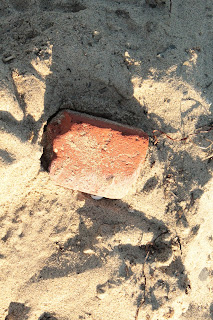It's a battle of chess, really. There are two opposing forces and many possible moves on both sides. In three moves, a rainforest is cut down to graze cattle for burgers and the resulting methane cuts a hole in the ozone. The opening forces the fish to keep inching forward, northward, risking being picked off by new species or perhaps taking down a few themselves. The king hasn't moved from his fishing post, but right whales are getting struck by the boats and tangled by the gear as they pursue menhaden that have moved into cooler waters. Should the king castle, and fish somewhere else?
When I was on Prudence Island a few weeks ago, I got to see first-hand the various pieces in play to monitor and combat the effects of global warming. Our TOTES group got to test three water samples from different parts of the island to try to figure out where they were from. We looked at temperature, salinity, dissolved oxygen, pH, turbidity (how clear the water was), and sedimentation (anything in the water that settled to the bottom). We tested pH with tablets and a lot of shaking, comparing the color with a guide with three shades of pink and also used the probe I was familiar with creating slurries of soil and water to test soil pH.
They collect data at three sites. At the T Wharf in the south end of the island there is a 660002 ex02 SONDE sensor that collects data every 15 minutes for 3-4 hours. The four sensors inside are calibrated with known solutions and track temperature/salinity, pH, turbidity, dissolved oxygen, and chlorophyll. Problems with the sensor (or anything left in the water, really) are algae growing on them, raising the dissolved oxygen and turbidity, or getting inundated with sea creatures such as polychaete worms, anemones, barnacles, or mussels, which then bring in the species that prey on them. Once, one of the scientists on Prudence cleared off several mussels with a few sea stars predated them.
We were given various "mysteries" to solve using the online SWMP (System Wide Monitoring Program). Where turbidity has increased and dissolved oxygen had decreased, both turned out to be algal blooms, of which one was caused by fertilizer run-off. In another scenario, my partner actually had lived in the estuary are in Texas. I'm looking at the information on the sheet and trying to figure out how the mussels in the area went from scant numbers to a boom. I looked at the salinity and the march water had gotten much saltier. I thought it might be drought, but what had caused the boom? A flood? My partner knew there had been a drought, and being at the low end of the water table, when the higher elevated areas in Texas further north did get rain, it overflowed their dam, which had to be released. The influx of fresh water rebalanced the marsh to the benefit of the mussel population.
Coast.NOAA.gov/estuaries is the website that stores information on 29 estuary reserves (NERRS) and offers graphing tool for scientists and students alike. Launch the SWMP Graphing Tool. Then complete five easy steps: 1. Select the data you're looking for: water quality (WQ), meteorological (MET), nutrients (NUT). 2. Select the start and end dates you want to look at. (It's very interesting to look at data right before and after a natural disaster such as a hurricane.) 3. Select the station you want information from. 4. Select a parameter, such as air temperature, barometric pressure, various wind parameters, humidity, there are a number of choices. 5. Select an output (graph or CSV file that contains all the raw data). I looked at Hurricane Maria with the data from Puerto Rico from August 27th to September 27th. You can add parameters to your graph once the first 5 steps are complete. I looked at cumulative precipitation and wind speed. There was an enormous spike in both between September 19th and September 21st.
What use is all this data? It helps make future decisions, set up the chess pieces. Global warming puts more water into the atmosphere, leading to bigger storms. Data like this can be used for coastal management, researchers, and students, as well as fishermen and women, shellfish harvesters, tourism councils, real estate developers, search and rescue planning, weather forecasters, emergency vehicles needing access to non-flooded roads, and national decision makers.
So a lot of pieces are at play. What will your next move be?





















































































































